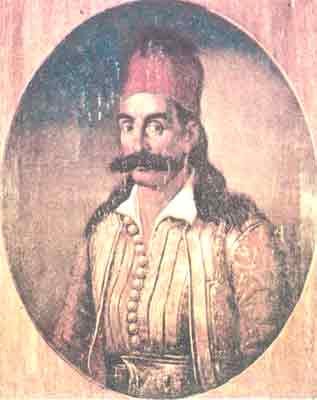People
Greek War Of Independence (1821-1829)
Georgios Karaiskakis (1780-1827)
Georgios Karaiskakis {Γεώργιος Καραϊσκάκης} (1780-1827) [Charles Nicolas Fabvier] [Richard Church] [Civil Wars]. Georgios Karaiskakis was born beside a cave close to the Monastery of Saint Georgios {Agios Georgios ~ Άγιος Γεώργιος} by Mavrommati {Μαυρομμάτι} village in the Agrafa {Άγραφα} highlands, Thessaly {Thessalia ~ Θεσσαλία}. Despite being frail, he was resilient under hardship. He often used his own money to provide for his men. In battle he would set an example and lead the way. He was very frank and very quick-tempered.
During efforts to liberate Athens [Place Names] from Reşit Mehmet Paşa (Kutahi) (1780-1839, Ottoman General and Grand Vezir) on April 22nd, 1827, to be precise, there was an engagement between Greeks and Ottomans. Although Karaiskakis was ill, he got on his horse and rode at full speed to be at the battle, first as always. He reached Neon Faliron [The Velodrome] [I.S.A.P.] and made his way forward, fighting all the way. But a shot seriously wounded him in the right groin and he fell from his horse. He was taken to the sailing ship "Spartiatis" {Σπαρτιάτης} (Spartan) where he died at 4 o'clock in the morning. It was Saint Georgios' day. He was buried the following day in the church of Saint Dimitrios {Agios Dimitrios ~ Άγιος Δημήτριος} on Salamis {Σαλαμίς}.
When King Otto [People] came to Greece, it was decided that his remains should be brought to the place where he had been mortally wounded. So in 1835 his remains were buried with highest honours in that place in Neon Faliron where his memorial stands. In tribute to the hero, King Otto removed the Grand Cross from his own chest and placed it on the casket wherein the bones of Karaiskakis lay.
Georgios Karaiskakis (1780-1827)

04-23-2004